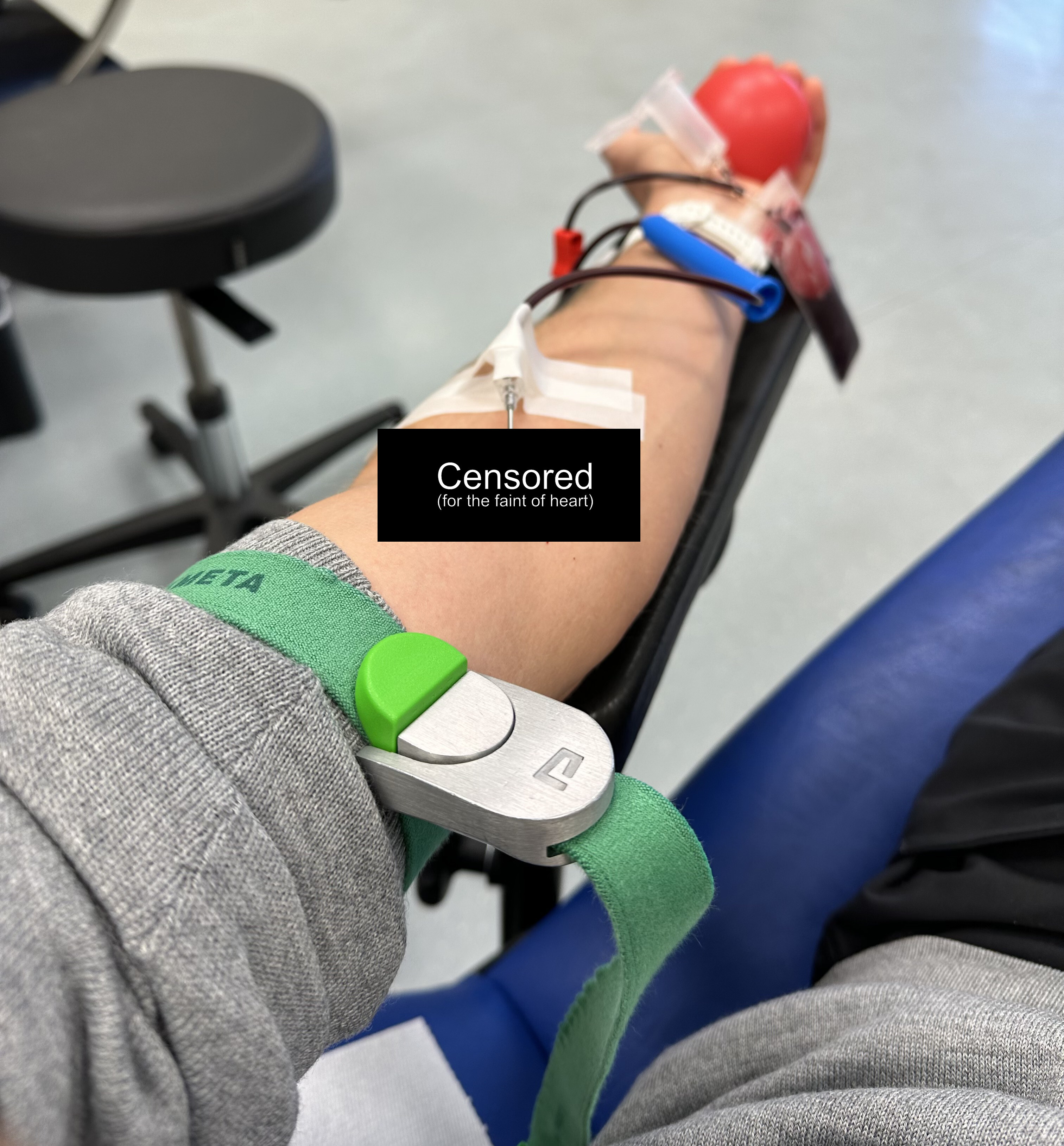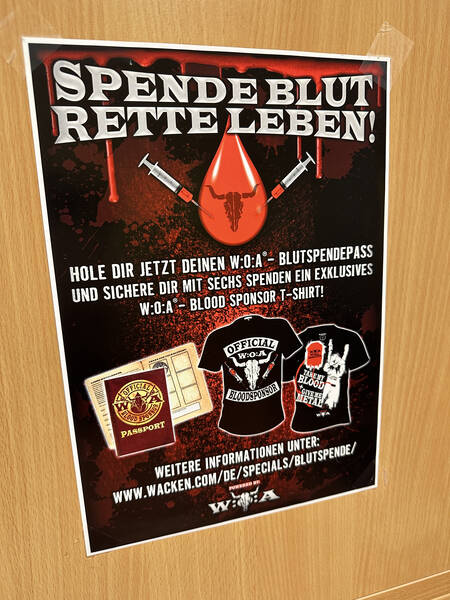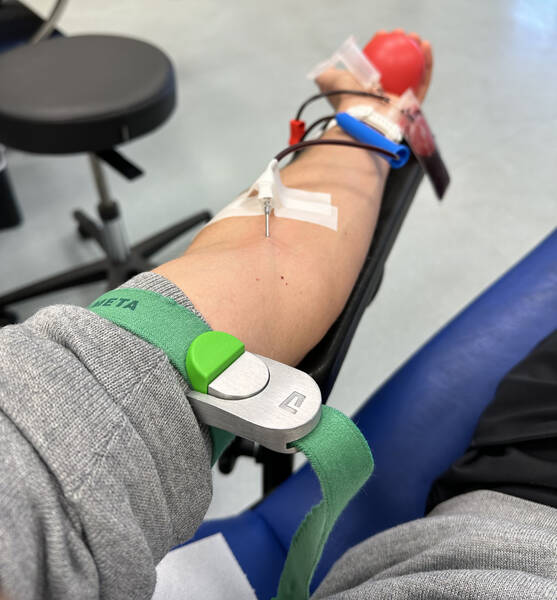What’s It Like to Donate Blood?

I think it’s fair to say everyone’s aware that giving blood is something any healthy human should probably do from time to time. Until we will have found a way to synthetically create human blood, there are no other options for helping people get through serious health hazards, operations, and similar. It’s also important for gaining new insights from scientific research to have a supply of human blood.
We agree it’s a good thing to do to help fellow humans.
But needles are scary!
And giving such a big part of what my body has made for itself to use, is that even a good idea? How does it impact me?
☝️ How It Works and What to Expect
First, you obviously need to find a place which accepts blood. In a large city that’s usually easily done within a minute of googling. Wherever you may live, checking Red Cross (US; Rotes Kreuz Germany) for more information might be useful.
In my hometown of Hamburg, Germany, we have four full-time centers which accept blood donations during working hours. The closest one to my home is just a 20 minute bike ride away.
As far as I understand, most of those places require you to make an appointment first. I had to wait for about two weeks. In this area, the reason isn’t that there are too many people trying to give blood, but rather the scarcity of medical professionals who are needed for it.
📅 Plan Your Donation Date
It’s best to choose a date and time of day on which you’re not required to do much else afterwards. So better not do this on the evening before a big race you want to run the next morning! Or anything else requiring your full attention and physical fitness, e.g. physically challenging work.
Donating blood takes a toll on the body, there is no sense in hiding this truth. This varies a lot for each individual, though. I had heard stories about people who needed the better part of a week to feel at one hundred percent again, but that seems to be a rarity.
It took me just about half a day to feel recovered.
I didn’t feel dizzy afterwards, just ever so slightly slow and tired.
But back to the process itself.
🏥 Arriving at the Donation Place
There was a bit of legal paperwork containing disclaimers about possible problems to go through and sign, before a medical attendant took my blood pressure and measured my blood sugar level using a drop of blood from my finger. Both results were fine.

I then had to go through a long checklist which mainly inquired information about my health status and behavior, including exotic travel, previous serious sicknesses such as malaria or hepatitis, and sexual habits.
It should be mentioned here that people who are gay or bisexual can have a hard time getting a permission to donate. The statistical risk of sexually transmitted diseases such as HIV is higher and can sometimes only be measured months later, creating a chance to transmit these diseases to the donation recipients. This is a charged topic and people are protesting.
Of course we all want to make sure the donated blood is as safe and healthy as possible so the people on the receiving end don’t end up with another unnecessary problem to deal with. My personal opinion is that we should leave those decisions to the medical professionals, but I can understand that some might feel discriminated against, and if the protests are productive and result in more research and findings which can help make blood donations of these groups safe after all, that’s a cause we should all unite behind.
The last bureaucratic paper I got handed had two stickers on it. I was supposed to read through it and than take one of the two and stick it on another sheet of paper in confidentiality. The stickers were barcodes which stood for either: “You can use my blood.” or “Please don’t use my blood.” respectively. I’ve learned this is called the “confidential unit exclusion” (CUE) method and helps people who are not comfortable sharing the information I’ve described on the earlier forms to implicitly state their blood wouldn’t be safe for a recipient. This provides another layer of safety and helps the donating person to avoid possible social stigma or pressure.
Before walking into the donation center, it was my understanding that they would just take a sample of my blood to check for any problems in a lab before green-lighting me for a proper donation on a different date. But that’s not the case, so the CUE method makes sense.
They take the half liter (17 fl oz) right then.
So, I wasn’t prepared for that, neither mentally nor physically. Mentally I could get myself in that headspace within a few minutes and overcome my fear of needles, fortunately. And for the physical side of it, the physician recommended me to go and have a medium sized meal and come back in half an hour. My breakfast was five hours before, so the chances of me not doing too great after the donation were too high.
I happily obliged because I felt hungry anyways. So, never donate blood on an empty stomach.
Drinking lots of water is also recommended, by the way, but that wasn’t a pressing problem for me then.
So I had a nice vegan burger at the restaurant near the donation center and returned relaxed and well-fed. They were ready for me and this philanthropic endeavor could begin. I think this also aided my mental well-being because us humans tend to feel more at ease with everything right after we’ve eaten.
🩸 The Donation Process Itself
The calming bedside manner of the experienced medical attendant certainly further helped me relax when she showed me one of the loungers which would be mine for the next half an hour. This place had room for about 20 or 30 simultaneous donations, but just around five were occupied at this point. We exchanged friendly greetings and it felt like becoming part of an altruistic group suddenly. A stranger lying here and donating blood emits this aura of being a good person, I noticed. This is a good feeling, it’s a safe space.

I closed my eyes and was so relaxed I nearly drifted off when she put that little needle into my left arm. I had imagined it to be more significant, but it turns out there have been some technological advancements as well. Also, the professional was really good at it and my athlete veins were so visible it was a delight for her to do this, she said.
She told me it takes about 10-15 minutes on average for those 500 mils (17 fl oz) to flow into the bag. Additionally, they take a small 20 ml (.7 fl oz) tube of my blood to send to the lab for testing. If they find any undiagnosed diseases in it, they would inform me and I would have gotten a free test out of it. If there’s nothing majorly wrong with my blood, I wouldn’t hear from them again.
The tubing between my arm, the bag, and the machine would waste about another 30 mils (1 fl oz). I got a tennis ball like toy to squeeze with my left hand’s fingers (not the thumb), so the blood flow would be stimulated.
And then it’s just time to wait until the bag is full. Some people on the other loungers had to be reminded to squeeze that ball harder by a loud beeping sound the machine made because the blood flow apparently wasn’t sufficient. I was doing great, though, and read my book using the kindle I had brought.
After a surprisingly short six minutes and seventeen seconds, I was done. Apparently there’s a lot of blood flowing fast through my body. My brain immediately saved the information so I could try and break that new personal best next time – I guess I’m conditioned that way! 😄
🔍 What Happens Next
I feel a lot better than I had expected. The attendant puts a thick bandage around my arm and hands me two Dextro Energy. I am told I should keep lying here on the lounger for another twenty to thirty minutes so they can watch me in case my body reacts in any weird way. Some people can faint or start having stomach issue, they said. I happily oblige and read a bit longer. But to me, thankfully, nothing extraordinary happens.
After that period I am free to go home, or take a few free snacks first. I ask my most pressing last question, which is “when can I safely do sports again?” and receive a good answer: After 24 hours, but better stay in the low effort range and see how the body reacts. That’s a good enough answer for me because it doesn’t jeopardize my nearly 700 consecutive days of running for at least one mile. I would have continued tomorrow anyways, but it’s good to know it’s also mostly safe to do so. Some more recommendations included not to visit the sauna today or do anything which would put a similar stress on the cardiovascular system. I wasn’t planning to do that anyways.
And that’s all there is to it! I’m very glad I went through with this after having had it on my bucket list for so long. Feels good to have faced those fears, done something good for an anonymous recipient whose life might depend on this, and putting this into my “Done” category.
Of course it’s cool to give blood more than once. And when I learned that people receive a donor’s certificate which holds your history and serves as an identifier for the center only after donating three times, the task moved from my “Done” category to the “In Progress” category.
I’ve already booked my next appointment which will be in mid January, because they allow men to donate only six times per year for safety reasons. Women are allowed to only give blood four times per year, the reason being their periodic biological loss of blood.
Slowly walking and biking home presented no challenge to me. I did so very carefully, and the only thing which was slightly uncomfortable was the thick bandage which nearly prevented my arm from bending. That’s all.
🌅 The Days After
Sophie and I had planned this day beforehand in case it turns out I would return from donating super tired and in need of a nap. She was prepared to take care of the kids and the housework for the rest of the day. I actually did feel a little tired, but again, it was a lot better than expected. I watched mindless YouTube for half an hour and that was it. Afterwards I was basically fully capable of sharing the day’s workload at home. A few hours later it was safe to finally remove the bandage so I could move my arm freely again. I made sure to drink lots of water, eat well, and take an additional iron supplementing pill which I usually have once per day because of eating mostly plants.
The next morning I felt as if nothing had happened, honestly. I did an easy run in the morning, no threshold or VO2max training would make sense now. And after that, everything else was back to normal, too.
The weird thing was, I actually started feeling better and more energetic for a few days. My wife Sophie, who is a physician herself, found out that this phenomenon occurs sometimes, and the reasoning is that when the body notices the blood loss it may overcompensate and create all this fresh new blood to re-establish the healthy balance. Fresh new blood in my veins sounds great and just the thought of it elevated my mood. May have been a placebo effect, but I’ll take it.
💰 Are You Getting Paid for Giving Blood?
No, you’re not. At least not where I did it. I remember that years ago some friends of mine found out you can get around twenty bucks per donation, which was a lot during college, but those days are seemingly over. But this is not because money is tight in the health sector, it’s for a psychological reason!
I recently read about it in the brilliant book Freakonomics by Steven Levitt and Stephen J. Dubner.
There’s such a thing called “Self-Determination Theory” (SDT, not to be confused with STD, a sexually transmitted disease). You might know that humans have intrinsic motivations and extrinsic motivations. And intrinsic motivation can be the desire to perform an action because it is satisfying or interesting, while an extrinsic motivation is doing something for external rewards, such as a payment.
Donating blood without payment will attract people who are intrinsically motivated, because they have a sense of altruism, feel personal satisfaction from doing good, or see it as a moral duty.
Offering payments will attract different kinds of people who maybe shouldn’t be there for their own good. But more importantly, if the payment is small, like the mentioned amount of 20 euros or dollars, even initially intrinsically motivated people we come to see this as a neutral financial transaction with no major benefit to themselves and it thereby reduces the attractiveness for those people, too, resulting in fewer donations overall.
Therefore, oddly enough, not paying donors leads to more donors.
Behavioral economics and psychology are quite interesting fields I think.
That all being said, not every donation center does it this way. Some offer money, especially for donating blood plasma, which you can do every week. I think I’m going to try that one day, too. Just to see what the difference feels like.
Sophie also told me that the donated blood isn’t just used to give it to people in need because of a big operation, disease, or injury. It’s also used for scientific research. This may be done by pharmaceutical companies who want to develop new methods of curing disease for gaining profit. Surely, this is a double edged sword. I think we still have no other choice than to keep donating, even if some corporate guys end up financing their private jets from it. The world is hugely complicated and everything is connected. Stopping to donate would create more problems than it solved.
That concludes what I know and think about this topic – I hope to have brought some clarity to it and made you think about going to donate blood as well in case you haven’t already done so.
How about starting at June 14th of 2024, which is World Blood Donor Day – initiated by the World Health Organization.
It’s simple, doesn’t cause any trouble to you, and will help other humans.
Click this link to put “blood donation center near me” into Google!
How do you feel after reading this?
This helps me assess the quality of my writing and improve it.
Leave a Comment